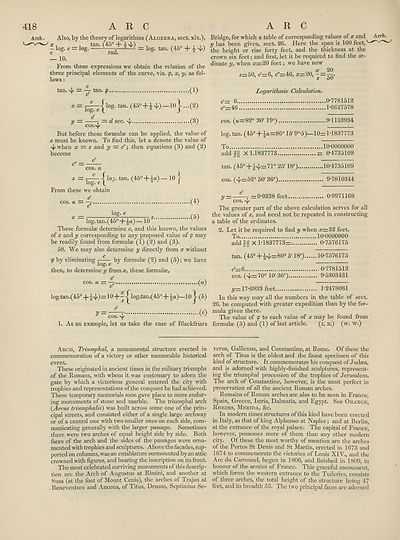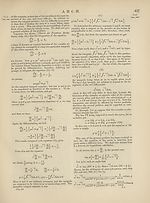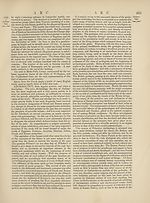Encyclopaedia Britannica > Volume 3, Anatomy-Astronomy
(426) Page 418 - ARC
Download files
Complete book:
Individual page:
Thumbnail gallery: Grid view | List view

418 ARC
Arch. Also, by the theory of logarithms (Algebra, sect, xix.),
~^racr~ ^ ^ = tan’ 2 "'J')
— 10.
From these expressions we obtain the relation of the
three principal elements of the curve, viz. <p, x, y, as fol¬
lows :
x. , tan
- ^g. e = log. —
ARC
Bridge, for which a table of corresponding values of x and
y has been given, sect. 26. Here the span is 100 feet,v
the height or rise forty feet, and the thickness at the
crown six feet; and first, let it be required to find the or¬
dinate y, when xzz20 feet; we have now
x 20
5=50, 6'= 6, c"= 46, *=20, - = —.
Arch.
tan. 4/ = — tan. a>.
c
•(1)
y
;|log. tan. (450 + l>4/)—lo|...(2)
d sec. 4/ (3)
log. e
d
cos^
But before these formulae can be applied, the value of
c must be known. To find this, let a denote the value of
^when x — s and y — d'\ then equations (3) and (2)
become
c" =
cos. a
c
log. e
From these we obtain
d
-j^log. tan. (45° + -|a) — 10
cos. a =
log. e
.(4)
.(5)
log. tan. (45°—10
These formulae determine c, and this known, the values
of * and y corresponding to any proposed value of p may
be readily found from formulae (1) (2) and (3).
58. We may also determine y directly from * without
c
<p by eliminating by formulae (2) and (5); we have
log. e
then, to determine y from *, these formulae,
d
d'
•O)
log.tan.(45° -j- 10+~ ^ log.tan.(45° + \od)—10 (b)
d / ^
* cos. 4/ v 7
1. As an example, let us take the case of Blackfriars
Logarithmic Calculation.
d- 6 0-7781512
c"=46 1-6627578
cos. (a=82° 30' 19") 9-1153934
log. tan. (45° + ia=860 15'9"-5)—10=1-1837773
To 10-0000000
addf{} X 1.1837773 = 0-4735109
tan. (45° + £4'=710 25' 18") 10-4735109
cos. (4'=52° 50' 36") 9-7810344
y = —^-T =9-9338 feet 0-9971168
J cos. 4/
The greater part of the above calculation serves for all
the values of *, and need not be repeated in constructing
a table of the ordinates.
2. Let it be required to find y when *=32 feet.
To 10-0000000
add X 1-1837773= 0-7576175
tan. (45° +^=80° 5' 18") 10-7576175
d=6 0-7781512
cos. (4/= 70° lO'36") 9-5303431
#= 17-6933 feet 1-2478081
In this way may all the numbers in the table of seel.
26. be computed with greater expedition than by the for¬
mula given there.
The value of <p to each value of * may be found from
formulae (5) and (1) of last article. (j. r.) (w. w.)
Arch, Triumphal, a monumental structure erected in
commemoration of a victory or other memorable historical
event
These originated in ancient times in the military triumphs
of the Romans, with whom it was customary to adorn the
gate by which a victorious general entered the city with
trophies and representations of the conquest he had achieved.
These temporary memorials soon gave place to more endur¬
ing monuments of stone and marble. The triumphal arch
(Arcus triumphalis) was built across some one of the prin¬
cipal streets, and consisted either of a single large archway
or of a central one with two smaller ones on each side, com¬
municating generally with the larger passage. Sometimes
there were two arches of equal height side by side. Both
faces of the arch and the sides of the passages were orna¬
mented with trophies and sculptures. Above the facades, sup¬
ported on columns, was an entablature surmounted by an attic
crowned with figures, and bearing the inscription on its front.
The most celebrated surviving monuments of this descrip¬
tion are the Arch of Augustus at Rimini, and another at
Susa (at the foot of Mount Cenis), the arches of Trajan at
Beneventum and Ancona, of Titus, Drusus, Septimius Se-
verus, Gallienus, and Constantine, at Rome. Of these the
arch of Titus is the oldest and the finest specimen of this
kind of structure. It commemorates his conquest of Judaea,
and is adorned with highly-finished sculptures, represent¬
ing the triumphal procession of the trophies of Jerusalem.
The arch of Constantine, however, is the most perfect in
preservation of all the ancient Roman arches.
Remains of Roman arches are also to be seen in France,
Spain, Greece, Istria, Dalmatia, and Egypt. See Orange,
Rheims, Merida, &c.
In modern times structures of this kind have been erected
in Italy, as that of king Alphonso at Naples ; and at Berlin,
at the entrance of the royal palace. The capital of France,
however, possesses more of them than any other modern
city. Of these the most worthy of mention are the arches
of the Fortes St Denis and St Martin, erected in 1673 and
1674 to commemorate the victories of Louis XIV., and the
Arc du Carrousel, begun in 1806, and finished in 1809, in
honour of the armies of France. This graceful monument,
which forms the western entrance to the Tuileries, consists
of three arches, the total height of the structure being 47
feet, and its breadth 55. 1 he two principal faces are adorned
Arch. Also, by the theory of logarithms (Algebra, sect, xix.),
~^racr~ ^ ^ = tan’ 2 "'J')
— 10.
From these expressions we obtain the relation of the
three principal elements of the curve, viz. <p, x, y, as fol¬
lows :
x. , tan
- ^g. e = log. —
ARC
Bridge, for which a table of corresponding values of x and
y has been given, sect. 26. Here the span is 100 feet,v
the height or rise forty feet, and the thickness at the
crown six feet; and first, let it be required to find the or¬
dinate y, when xzz20 feet; we have now
x 20
5=50, 6'= 6, c"= 46, *=20, - = —.
Arch.
tan. 4/ = — tan. a>.
c
•(1)
y
;|log. tan. (450 + l>4/)—lo|...(2)
d sec. 4/ (3)
log. e
d
cos^
But before these formulae can be applied, the value of
c must be known. To find this, let a denote the value of
^when x — s and y — d'\ then equations (3) and (2)
become
c" =
cos. a
c
log. e
From these we obtain
d
-j^log. tan. (45° + -|a) — 10
cos. a =
log. e
.(4)
.(5)
log. tan. (45°—10
These formulae determine c, and this known, the values
of * and y corresponding to any proposed value of p may
be readily found from formulae (1) (2) and (3).
58. We may also determine y directly from * without
c
<p by eliminating by formulae (2) and (5); we have
log. e
then, to determine y from *, these formulae,
d
d'
•O)
log.tan.(45° -j- 10+~ ^ log.tan.(45° + \od)—10 (b)
d / ^
* cos. 4/ v 7
1. As an example, let us take the case of Blackfriars
Logarithmic Calculation.
d- 6 0-7781512
c"=46 1-6627578
cos. (a=82° 30' 19") 9-1153934
log. tan. (45° + ia=860 15'9"-5)—10=1-1837773
To 10-0000000
addf{} X 1.1837773 = 0-4735109
tan. (45° + £4'=710 25' 18") 10-4735109
cos. (4'=52° 50' 36") 9-7810344
y = —^-T =9-9338 feet 0-9971168
J cos. 4/
The greater part of the above calculation serves for all
the values of *, and need not be repeated in constructing
a table of the ordinates.
2. Let it be required to find y when *=32 feet.
To 10-0000000
add X 1-1837773= 0-7576175
tan. (45° +^=80° 5' 18") 10-7576175
d=6 0-7781512
cos. (4/= 70° lO'36") 9-5303431
#= 17-6933 feet 1-2478081
In this way may all the numbers in the table of seel.
26. be computed with greater expedition than by the for¬
mula given there.
The value of <p to each value of * may be found from
formulae (5) and (1) of last article. (j. r.) (w. w.)
Arch, Triumphal, a monumental structure erected in
commemoration of a victory or other memorable historical
event
These originated in ancient times in the military triumphs
of the Romans, with whom it was customary to adorn the
gate by which a victorious general entered the city with
trophies and representations of the conquest he had achieved.
These temporary memorials soon gave place to more endur¬
ing monuments of stone and marble. The triumphal arch
(Arcus triumphalis) was built across some one of the prin¬
cipal streets, and consisted either of a single large archway
or of a central one with two smaller ones on each side, com¬
municating generally with the larger passage. Sometimes
there were two arches of equal height side by side. Both
faces of the arch and the sides of the passages were orna¬
mented with trophies and sculptures. Above the facades, sup¬
ported on columns, was an entablature surmounted by an attic
crowned with figures, and bearing the inscription on its front.
The most celebrated surviving monuments of this descrip¬
tion are the Arch of Augustus at Rimini, and another at
Susa (at the foot of Mount Cenis), the arches of Trajan at
Beneventum and Ancona, of Titus, Drusus, Septimius Se-
verus, Gallienus, and Constantine, at Rome. Of these the
arch of Titus is the oldest and the finest specimen of this
kind of structure. It commemorates his conquest of Judaea,
and is adorned with highly-finished sculptures, represent¬
ing the triumphal procession of the trophies of Jerusalem.
The arch of Constantine, however, is the most perfect in
preservation of all the ancient Roman arches.
Remains of Roman arches are also to be seen in France,
Spain, Greece, Istria, Dalmatia, and Egypt. See Orange,
Rheims, Merida, &c.
In modern times structures of this kind have been erected
in Italy, as that of king Alphonso at Naples ; and at Berlin,
at the entrance of the royal palace. The capital of France,
however, possesses more of them than any other modern
city. Of these the most worthy of mention are the arches
of the Fortes St Denis and St Martin, erected in 1673 and
1674 to commemorate the victories of Louis XIV., and the
Arc du Carrousel, begun in 1806, and finished in 1809, in
honour of the armies of France. This graceful monument,
which forms the western entrance to the Tuileries, consists
of three arches, the total height of the structure being 47
feet, and its breadth 55. 1 he two principal faces are adorned
Set display mode to:
![]() Universal Viewer |
Universal Viewer | ![]() Mirador |
Large image | Transcription
Mirador |
Large image | Transcription
Images and transcriptions on this page, including medium image downloads, may be used under the Creative Commons Attribution 4.0 International Licence unless otherwise stated. ![]()
| Encyclopaedia Britannica > Encyclopaedia Britannica > Volume 3, Anatomy-Astronomy > (426) Page 418 - ARC |
|---|
| Permanent URL | https://digital.nls.uk/193762886 |
|---|
| Attribution and copyright: |
|
|---|---|
| Shelfmark | EB.16 |
|---|---|
| Description | Ten editions of 'Encyclopaedia Britannica', issued from 1768-1903, in 231 volumes. Originally issued in 100 weekly parts (3 volumes) between 1768 and 1771 by publishers: Colin Macfarquhar and Andrew Bell (Edinburgh); editor: William Smellie: engraver: Andrew Bell. Expanded editions in the 19th century featured more volumes and contributions from leading experts in their fields. Managed and published in Edinburgh up to the 9th edition (25 volumes, from 1875-1889); the 10th edition (1902-1903) re-issued the 9th edition, with 11 supplementary volumes. |
|---|---|
| Additional NLS resources: |
|

